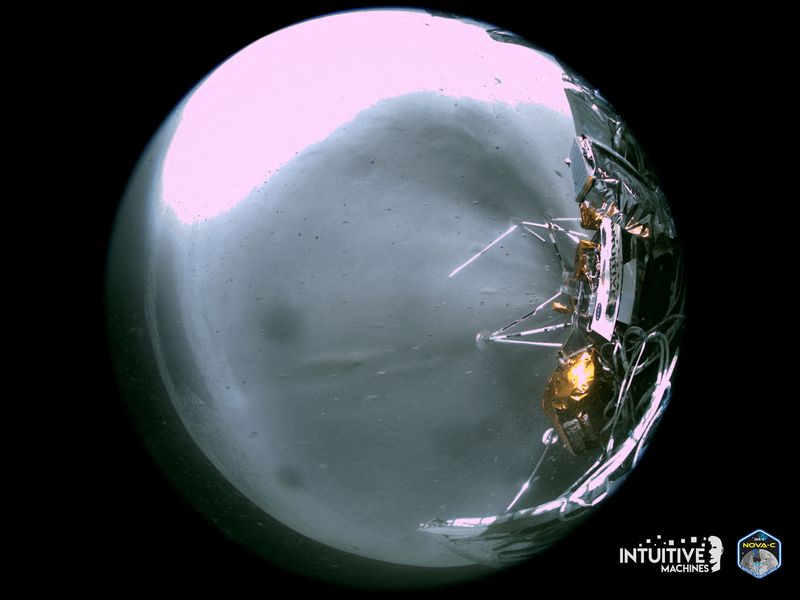By Joey Roulette and Steve Gorman
(Reuters) -Odysseus, the first U.S. spacecraft to land on the moon in half a century, lost power and went dormant on Thursday as it entered a frigid lunar nightfall, ending its mission a week after a lopsided touchdown that hindered operations and its scientific output.
Intuitive Machines, the Texas-based aerospace company that NASA paid $118 million to build and fly Odysseus, said its ground control team had received a final "farewell transmission" from the spacecraft before it went dark on the moon's south pole region.
"Goodnight, Odie. We hope to hear from you again," Intuitive said in an online update, referring to the spacecraft by the nickname its engineers had affectionately adopted for a lander they said proved to be more robust than expected.
Earlier in the day, Intuitive said its teams would program Odysseus to "phone home" to the company's ground control center Houston if and when the spacecraft receives enough solar power to reawaken in three weeks with the next sunrise over its landing site.
The company previously said Odysseus would likely run out of battery power sometime Wednesday night, just after its sixth full day on the moon, as the sun sank low on the lunar horizon and solar energy regeneration became insufficient.
But Intuitive said on Thursday morning that Odysseus was "still kicking," and that flight controllers would seek to download a final stream of data transmitted the 239,000 miles (385,000km) back to Earth before contact was lost.
Intuitive's shares - which had nearly tripled and then plummeted in wild swings over the course of the mission - remained up about 20% from just before the launch, giving the company a market value of about $600 million.
LOPSIDED LANDING
The six-legged Nova-C-class lander, shaped like a hexagonal cylinder and standing 13 feet (4 m) tall, was launched on Feb. 15 from NASA's Kennedy Space Center in Florida on a Falcon 9 rocket supplied by Elon Musk's SpaceX. It arrived in lunar orbit six days later.
The vehicle reached the lunar surface last Thursday after an 11th-hour navigational glitch and nail-biting descent that ended with Odysseus catching one of its feet on the ground and landing in a sharply tilted position, immediately impeding its operations and limiting data retrieval.
Intuitive Machines have said human error was to blame for the navigational issue. Flight readiness teams had neglected to manually unlock a safety switch before launch, preventing subsequent activation of the vehicle's laser-guided range finders and forcing flight engineers to hurriedly improvise an alternative during lunar orbit.
The last-minute work-around likely prevented a crash-landing but may have contributed to the vehicle landing askew, apparently catching a foot on the uneven surface and coming to rest leaning at a 30-degree angle, company officials said.
An image released on Wednesday showed the spacecraft with its landing gear visibly damaged as it touched down on the moon.
The company has said that two of the lander's antennae were knocked out of commission, and its solar panels were likewise facing the wrong direction.
Despite persistent difficulties in communicating with the lander and keeping its solar batteries charged, NASA said it managed to extract some data from all six of its science payloads delivered by Odysseus. Other customers with instruments on board saw mixed results.
Still, Intuitive and NASA executives hailed the science achieved and the "soft" lunar landing itself - the first ever by a commercially manufactured and operated space vehicle - as a key breakthrough in a new chapter of lunar exploration.
One particular advance touted by Intuitive was the success of the proprietary propulsion system it developed for the lander, the first vehicle whose deep-space flight was powered by a mix of liquid methane and liquid oxygen.
Odysseus was also the first U.S. spacecraft to make a controlled descent to the lunar surface since NASA's final crewed Apollo mission to the moon in 1972.
And it was the first under NASA's Artemis program, which aims to send several more commercial robot landers to the moon on science scouting missions ahead of a planned return of astronauts to Earth's only natural satellite later this decade.
Two other Intuitive Machine moon landers are slated for launch later this year.
To date, space agencies of just four other countries have ever achieved a "soft" moon landing - the former Soviet Union, China, India and, just last month, Japan, whose lander likewise tipped over and experienced power-regeneration problems.

Earlier this week, Japan's space agency said its lander had unexpectedly survived a lunar night and re-established communications with Earth a month weeks after going dormant.
The United States is the only country ever to have sent humans to the lunar surface.